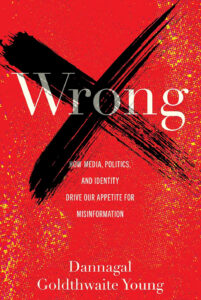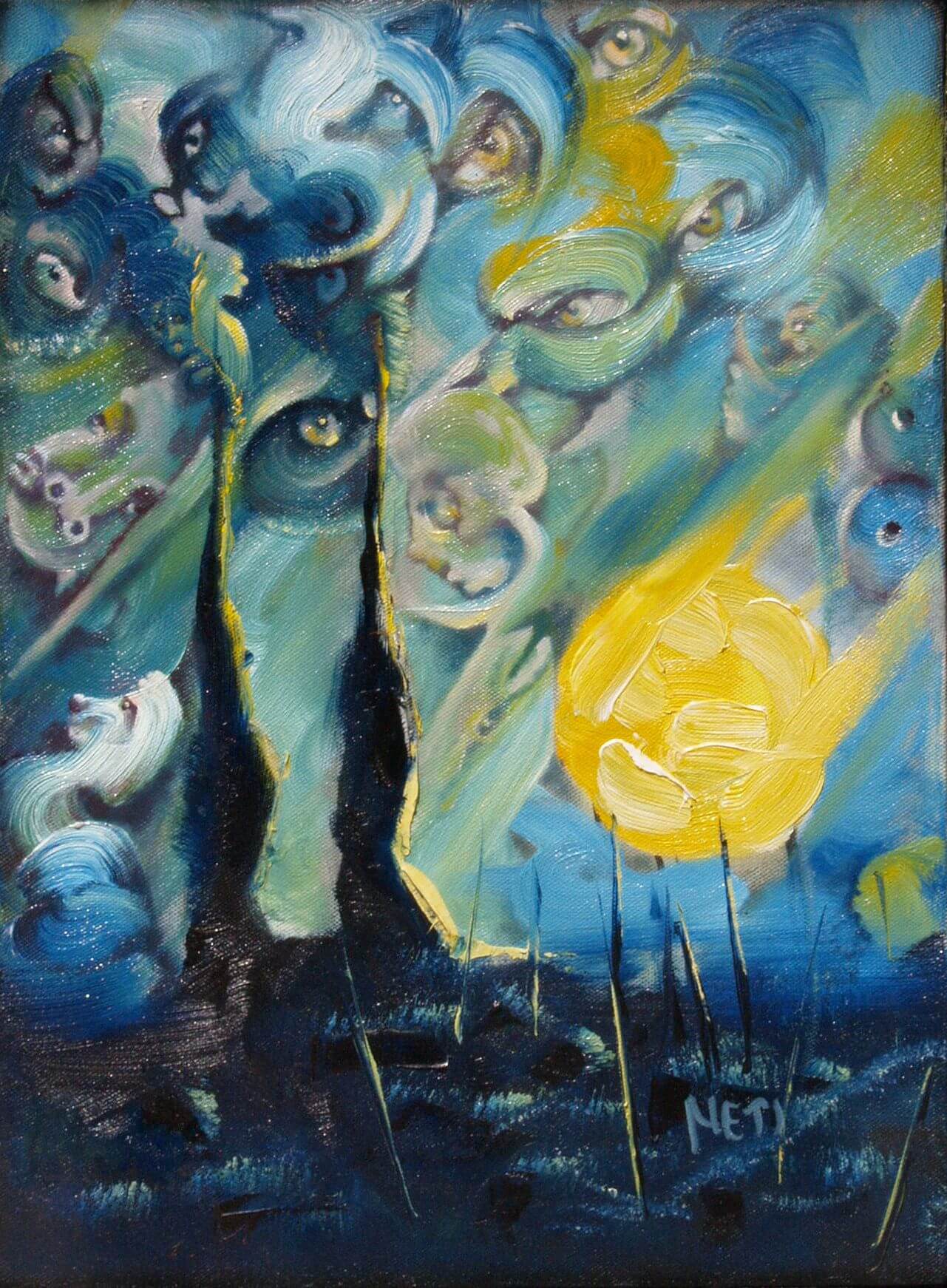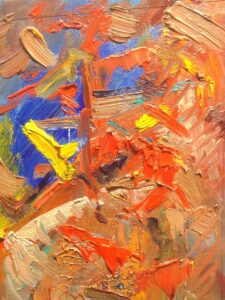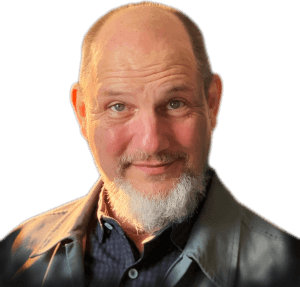 Dannagal Goldtnwaite Young has written a book called Wrong, which was recently featured on an episode of Hidden Brain (on NPR), called, “Sitting with Uncertainty.” Wrong is a very enlightening book that not only sheds a much needed light on our political divide but also on the age old divide between realist and abstract art. Young looks to explain how the “conspiracy curious” gravitate to conspiracy theories to give them a sense of comprehension and control, in an increasingly complex world. We are all trying to process these tricky, difficult times, to feel less frightened. She discusses the deep need for comprehension and control in supplying a feeling of agency and how this effects our political beliefs. Some of us long for the answer to “how people like me” tend to deal with these complexities? It is human nature to group people into those “like me” and those “like them.” In this causal factory our observations are theory laddened, meaning they are effected by a myriad of information coming toward us, some of it true, but much of it laddened with untruths and corrupted conclusions. In science, researchers make theoretical assumptions, which they assume are false until proven possibly true, until another theory based on more data proves that theory false. And so on.
Dannagal Goldtnwaite Young has written a book called Wrong, which was recently featured on an episode of Hidden Brain (on NPR), called, “Sitting with Uncertainty.” Wrong is a very enlightening book that not only sheds a much needed light on our political divide but also on the age old divide between realist and abstract art. Young looks to explain how the “conspiracy curious” gravitate to conspiracy theories to give them a sense of comprehension and control, in an increasingly complex world. We are all trying to process these tricky, difficult times, to feel less frightened. She discusses the deep need for comprehension and control in supplying a feeling of agency and how this effects our political beliefs. Some of us long for the answer to “how people like me” tend to deal with these complexities? It is human nature to group people into those “like me” and those “like them.” In this causal factory our observations are theory laddened, meaning they are effected by a myriad of information coming toward us, some of it true, but much of it laddened with untruths and corrupted conclusions. In science, researchers make theoretical assumptions, which they assume are false until proven possibly true, until another theory based on more data proves that theory false. And so on.

But in the real world, team identity comes first. Confirmation bias is becoming more widespread; people are looking for and finding information that confirms their bias. Our goal is to feel like we know, not to actually know. Our views are shaped by social identity. Media uses this to control the narrative, engaging in ideological identity sorting. Party identification is an us vs them equation. Young’s thesis centers on there being two basics types of people, those with a greater tolerance for uncertainty, who are more accepting of not always needing a clear reason for everything and those with a strong need for cognition, who prefer a clear, easy explanation for complex problems, assigning a threat and generating outrage. Those with a strong need for cognition, know exactly who to fear and who to blame. They have a high need for closure. To be honest, such people frighten me.
On air, the author used our taste in art to illustrate the distinction. Those who are okay with abstract art – not needing to know what it is or what it is about have a high tolerance for uncertainty, they are comfortable in a place of ambiguity. They do not have a strong need for cognition, that it is to say, they don’t need to understand a work of art completely to appreciate it. They are comfortable spending time, allowing the work to reveal itself in its own way. Whereas those with a high need for cognition need the art to make sense right away or it really upsets them. Those who only prefer realism have a strong need for cognition; they are happier when they understand what they are looking at and what is expected of them when they talk about it. I was hoping for more of this conversation about abstract vs realistic art, but apparently that was just for the radio audience. I bought her book and no where has she brought up what she discussed on the show, namely tolerance for ambiguity as it relates to abstract versus realistic art. I was disappointed. My theory is that one can be a good realist if they have a high need for cognition. But to be a great realist, we need to be comfortable with uncertainty. To really understand a nose, for instance, we need to be able to see and analyze it in its most abstract forms. That is to say, to be a great realist we must be an excellent abstractionist.
I find this conversation most interesting, as an artist. There is a place when an artist is completely free. I use a variety of exercises to help artists find what I call the unselfconscious line. It is a place where the artist develops the ability to skip past the ego in connecting the soul directly with the hand. This is useful not only in the making of abstract art but in realism as well. The artist must develop a tolerance for uncertainty, to create situations where the ego is unaware of what our true self is doing. It is a very liberating place to be, but it does require a high tolerance for uncertainty, which I believe we can develop with practice.

 I created a whole doppelgänger around this kind of work, an alt personality called Neti, who paints imaginary realism. I did this, mostly as a joke, so as not to confuse my “brand,” for those consumers with a high need for cognition. Of course these people usually don’t get the joke, so the jokes on me. The fact that so many people need for an artist to present a brand, a way of painting that distinguishes them and makes them special, to me is another manifestation of this need for cognition, this need to know exactly what they are getting as a consumer. I think this makes perfect sense in the consuming of toothpaste but not so much in the realm of the artistic. I have always cultivated a diversity of tastes in art and appreciate the myriad of approaches. I resist the brand called realist to describe my tastes and what I’m liable to create on a given day. I treasure artistic freedom over this idea of branding and believe an artist should never limit themselves to one way of creating. Of course, this tends to create confusion for many would be collectors. In this sense, I think it has likely impeded my career. But I consider it a small price to pay not to be placed in a box.
I created a whole doppelgänger around this kind of work, an alt personality called Neti, who paints imaginary realism. I did this, mostly as a joke, so as not to confuse my “brand,” for those consumers with a high need for cognition. Of course these people usually don’t get the joke, so the jokes on me. The fact that so many people need for an artist to present a brand, a way of painting that distinguishes them and makes them special, to me is another manifestation of this need for cognition, this need to know exactly what they are getting as a consumer. I think this makes perfect sense in the consuming of toothpaste but not so much in the realm of the artistic. I have always cultivated a diversity of tastes in art and appreciate the myriad of approaches. I resist the brand called realist to describe my tastes and what I’m liable to create on a given day. I treasure artistic freedom over this idea of branding and believe an artist should never limit themselves to one way of creating. Of course, this tends to create confusion for many would be collectors. In this sense, I think it has likely impeded my career. But I consider it a small price to pay not to be placed in a box.
Anyway, back to the book. Apparently the population is evenly divided between those who have this high tolerance for uncertainty, and those with a low tolerance for ambiguity, who would rather have everything wrapped up nice and neat in a bow, so it all makes sense. This results in their acting more on fear. They are more susceptible to scapegoating and blaming of the other. They look to conspiracy theories to explain the way of the world. Even after reading most of the book, I don’t understand this way of thinking. The author promises to offer a solution to this problem, but I have not gotten that far in the book. So I must learn to be comfortable in the ambiguity of not knowing the answer. Can we as a society bridge this gap and learn to live with each other or will we forever be at each others’ throats? Honestly, I believe there is room for both types of people in the world if we don’t kill each other in the process.

 Would you like to get inspiration in your inbox, rather than ads for more stuff? Welcome to ManiscalcoGallery.com
Would you like to get inspiration in your inbox, rather than ads for more stuff? Welcome to ManiscalcoGallery.com